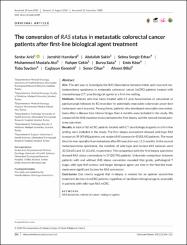| dc.contributor.author | Arıcı, Serdar | |
| dc.contributor.author | Hamdard, Jamshid | |
| dc.contributor.author | Sakin, Abdullah | |
| dc.contributor.author | Şengiz Erhan, Selma | |
| dc.contributor.author | Atçı, Muhammed Mustafa | |
| dc.contributor.author | Cekin, Ruhper | |
| dc.contributor.author | Saka, Burcu | |
| dc.contributor.author | Köse, Emin | |
| dc.contributor.author | Saydam, Tuba | |
| dc.contributor.author | Geredeli, Çağlayan | |
| dc.contributor.author | Cihan, Şener | |
| dc.contributor.author | Bilici, Ahmet | |
| dc.date.accessioned | 2021-03-18T11:53:28Z | |
| dc.date.available | 2021-03-18T11:53:28Z | |
| dc.date.issued | 2021 | en_US |
| dc.identifier.citation | Arıcı, S., Hamdard, J., Sakin, A., Şengiz Erhan, S., Atçı, M. M., Cekin, R. ... Bilici, A. (2021). The conversion ofRASstatus in metastatic colorectal cancer patients after first-line biological agent treatment. Colorectal Disease, 23(1), 206-212. https://dx.doi.org/10.1111/codi.15389 | en_US |
| dc.identifier.issn | 1462-8910 | |
| dc.identifier.issn | 1463-1318 | |
| dc.identifier.uri | https://dx.doi.org/10.1111/codi.15389 | |
| dc.identifier.uri | https://hdl.handle.net/20.500.12511/6624 | |
| dc.description.abstract | Aim The aim was to investigate theRASdiscordance between initial and recurrent metastasectomy specimens in metastatic colorectal cancer (mCRC) patients treated with chemotherapy (CT) plus biological agents in a first-line setting. Methods Patients who had been treated with CT plus bevacizumab or cetuximab or panitumumab followed by R0 resection for potentially resectable colorectal cancer liver metastases were scanned. Among these, patients who developed resectable new metastases after a disease-free interval longer than 6 months were included in the study. We compared theRASmutation status between the first biopsy and the second metastasectomy specimen. Results A total of 82 mCRC patients treated with CT plus biological agents in a first-line setting were included in the study. The first biopsy assessment showed wild-typeRAStumours in 39 (47.6%) patients and mutantRAStumours in 43 (52.4%) patients. The mean time for new operable liver metastasis after R0 resection was 15.5 months. In the second metastasectomy specimens, the numbers of wild-type and mutantRAStumours were 30 (36.6%) and 52 (63.4%), respectively. The comparison with the first biopsy specimens showedRASstatus conversions in 17 (20.7%) patients. Univariate comparison between patients with and withoutRASstatus conversion revealed that grade, pathological T stage, wild-typeRAStumour and longer biological agent use time in the first-line treatment were significant factors forRASconversion. Conclusion Our results suggest that re-biopsy is needed for an optimal second-line treatment decision in mCRC patients regardless of backbone biological agent, especially in patients with wild-typeRASmCRC. | en_US |
| dc.description.sponsorship | Interdisciplinary Oncology Association | en_US |
| dc.language.iso | eng | en_US |
| dc.publisher | Wiley | en_US |
| dc.rights | info:eu-repo/semantics/embargoedAccess | en_US |
| dc.subject | RAS Mutations | en_US |
| dc.subject | Colorectal Cancer | en_US |
| dc.subject | Biological Agents | en_US |
| dc.title | The conversion ofRASstatus in metastatic colorectal cancer patients after first-line biological agent treatment | en_US |
| dc.type | article | en_US |
| dc.relation.ispartof | Colorectal Disease | en_US |
| dc.department | İstanbul Medipol Üniversitesi, Tıp Fakültesi, Cerrahi Tıp Bilimleri Bölümü, Tıbbi Patoloji Ana Bilim Dalı | en_US |
| dc.department | İstanbul Medipol Üniversitesi, Tıp Fakültesi, Dahili Tıp Bilimleri Bölümü, İç Hastalıkları Ana Bilim Dalı | en_US |
| dc.authorid | 0000-0001-6830-7701 | en_US |
| dc.identifier.volume | 23 | en_US |
| dc.identifier.issue | 1 | en_US |
| dc.identifier.startpage | 206 | en_US |
| dc.identifier.endpage | 212 | en_US |
| dc.relation.publicationcategory | Makale - Uluslararası Hakemli Dergi - Kurum Öğretim Elemanı | en_US |
| dc.identifier.doi | 10.1111/codi.15389 | en_US |
| dc.identifier.wosquality | Q1 | en_US |
| dc.identifier.scopusquality | Q2 | en_US |


















